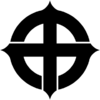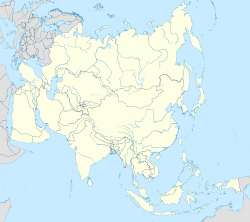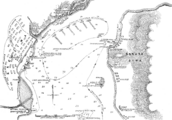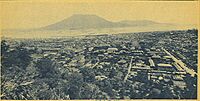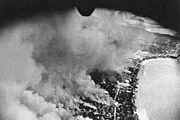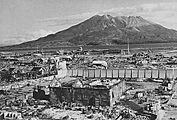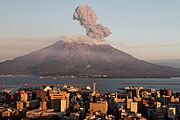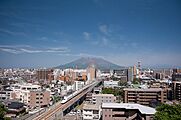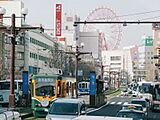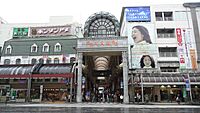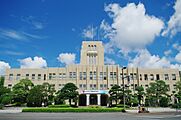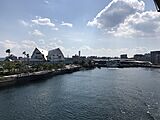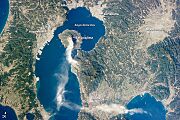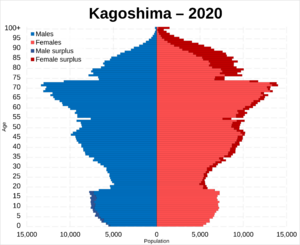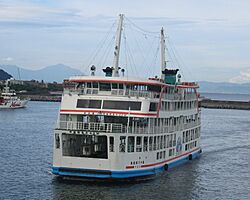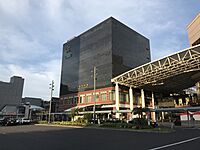Kagoshima facts for kids
Quick facts for kids
Kagoshima
鹿児島市
|
|||||||||||
|---|---|---|---|---|---|---|---|---|---|---|---|
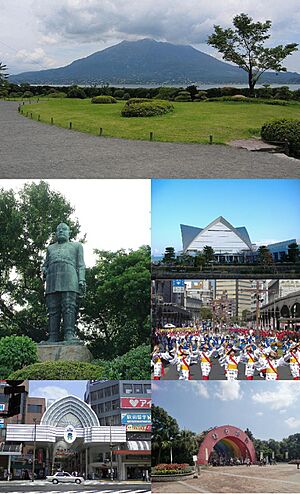
From top, left to right: Senga-en Garden, Saigō Takamori statue, Kagoshima Aquarium, Ohara Festival, Tenmonkan, Hirakawa Zoological Park
|
|||||||||||
|
|||||||||||
| Nickname(s):
"City of Ishin"
|
|||||||||||
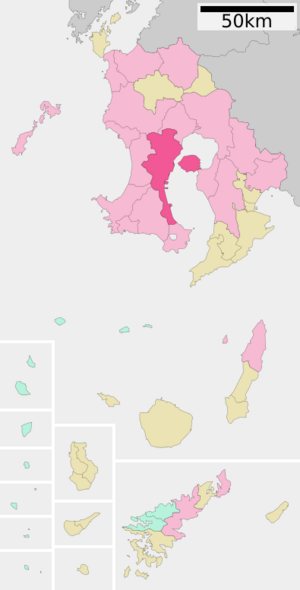
Location of Kagoshima in Kagoshima Prefecture
|
|||||||||||
| Country | Japan | ||||||||||
| Region | Kyushu | ||||||||||
| Prefecture | Kagoshima | ||||||||||
| City founded | April 1, 1889 | ||||||||||
| Area | |||||||||||
| • Total | 547.61 km2 (211.43 sq mi) | ||||||||||
| Population
(July 1, 2024)
|
|||||||||||
| • Total | 583,966 | ||||||||||
| • Density | 1,066.390/km2 (2,761.938/sq mi) | ||||||||||
| Time zone | UTC+9 (Japan Standard Time) | ||||||||||
| Phone number | 099-224-1111 | ||||||||||
| Address | 11-1 Yamashita-machi, Kagoshima-shi, Kagoshima-ken 892-8677 | ||||||||||
|
|||||||||||
Kagoshima City (鹿児島市, Kagoshima-shi, IPA: [kaɡoɕimaɕi]) is the capital city of Kagoshima Prefecture, Japan. It is located on the island of Kyushu. As of July 31, 2024, about 583,966 people live here. The city covers an area of about 547.61 square kilometers.
Contents
What's in a Name?
The Japanese characters for Kagoshima (鹿児島) mean "deer child island." But the real meaning might be different. It could come from words meaning "cliff" or "sailor" in the local Kagoshima language. People in the area also call the city Kagomma (かごっま) or Kagonma (かごんま).
A Look at Kagoshima's Past
Kagoshima has a long and interesting history.
Early History and Power
For many years, Kagoshima was the main city for the powerful Shimazu clan. This was from the late Kamakura period onwards. During the Edo period (1603–1868), Kagoshima became a busy port city. It was the center of the Shimazu's Satsuma Domain. This domain was one of the richest and strongest in Japan.
Even though Japan had strict rules against foreign trade, Kagoshima stayed active. It even had a special building for visitors from the Ryūkyū Kingdom. This kingdom was a semi-independent neighbor.
Important Events and Changes
Kagoshima was also a place where Christianity was important. This was before the religion was banned in Japan. The area was also known for being against the Tokugawa shogunate, which ruled Japan at the time.
In 1863, the British Royal Navy attacked Kagoshima. This was to punish the local ruler for an incident that happened the year before. Many leaders of the Meiji restoration, a big change in Japanese history, came from Satsuma.
Japan's Industrial Revolution is said to have started here. This was thanks to 19 young students from Satsuma. They secretly traveled to the United Kingdom to learn about new technology. When they came back, they shared what they learned. A statue of them stands outside the train station today.
Kagoshima is also the birthplace of Tōgō Heihachirō. He became a famous admiral in the Japanese Navy. After studying in England, he led the navy to big victories in the Russo-Japanese War. People called him the 'Nelson of the Orient'.
In 1912, the first tram line opened in Kagoshima. In 1914, the Sakurajima volcano erupted. It covered the city in ash, but people managed well.
-
Map of the Bombardment of Kagoshima on 15 to 18 August 1863
-
The city covered deep in ash after the 1914 eruption of the Sakurajima volcano which is seen in the distance across the bay
World War II and Growth
During World War II, Kagoshima was bombed in June 1945. A large part of the city was destroyed. The city was targeted because of its important naval port and railway connections.
The city of Kagoshima was officially founded on April 1, 1889. Over the years, it grew by merging with nearby towns. For example, it merged with Taniyama City in 1967. In 2004, it merged with five more towns, including Sakurajima Town. In 1996, Kagoshima became a "core city," which means it has more local control.
Kagoshima's Location and Environment
Kagoshima is at the very southwest tip of Kyūshū island. It is the biggest city in its prefecture. People sometimes call it the "Naples of the Eastern world." This is because it has a beautiful bay, a warm climate, and a famous volcano, Sakurajima.
The city is about 280 kilometers south of Fukuoka City. It's also about 180 kilometers south of Kumamoto City. Kagoshima covers part of the Satsuma Peninsula and all of Sakurajima island. Most flat areas are used for businesses, homes, and factories. Many hills and mountains near the city have homes built on them.
A unique challenge for Kagoshima is the ash from Sakurajima's eruptions. Residents have learned to live with it. For example, schoolchildren sometimes wear helmets to protect themselves from falling ash.
Nearby Cities and Towns
Kagoshima shares borders with several other places in Kagoshima Prefecture:
- Aira
- Hioki
- Ibusuki
- Minamikyūshū
- Minamisatsuma
- Satsumasendai
- Tarumizu
Kagoshima's Climate
Kagoshima has a humid subtropical climate. This means it has mild, mostly dry winters. Springs are warm and humid. Summers are hot and humid, and autumns are mild and dry. It has the highest average yearly temperature in mainland Japan.
| Climate data for Kagoshima (1991−2020 normals, extremes 1883−present) | |||||||||||||
|---|---|---|---|---|---|---|---|---|---|---|---|---|---|
| Month | Jan | Feb | Mar | Apr | May | Jun | Jul | Aug | Sep | Oct | Nov | Dec | Year |
| Record high °C (°F) | 23.9 (75.0) |
24.1 (75.4) |
27.6 (81.7) |
30.2 (86.4) |
31.7 (89.1) |
34.5 (94.1) |
37.2 (99.0) |
37.4 (99.3) |
35.7 (96.3) |
32.4 (90.3) |
29.5 (85.1) |
24.7 (76.5) |
37.4 (99.3) |
| Mean daily maximum °C (°F) | 13.1 (55.6) |
14.6 (58.3) |
17.5 (63.5) |
21.8 (71.2) |
25.5 (77.9) |
27.5 (81.5) |
31.9 (89.4) |
32.7 (90.9) |
30.2 (86.4) |
25.8 (78.4) |
20.6 (69.1) |
15.3 (59.5) |
23.1 (73.6) |
| Daily mean °C (°F) | 8.7 (47.7) |
9.9 (49.8) |
12.8 (55.0) |
17.1 (62.8) |
21.0 (69.8) |
24.0 (75.2) |
28.1 (82.6) |
28.8 (83.8) |
26.3 (79.3) |
21.6 (70.9) |
16.2 (61.2) |
10.9 (51.6) |
18.8 (65.8) |
| Mean daily minimum °C (°F) | 4.9 (40.8) |
5.8 (42.4) |
8.7 (47.7) |
12.9 (55.2) |
17.3 (63.1) |
21.3 (70.3) |
25.3 (77.5) |
26.0 (78.8) |
23.2 (73.8) |
18.0 (64.4) |
12.2 (54.0) |
6.9 (44.4) |
15.2 (59.4) |
| Record low °C (°F) | −5.7 (21.7) |
−6.7 (19.9) |
−3.9 (25.0) |
−1.0 (30.2) |
3.9 (39.0) |
9.0 (48.2) |
15.9 (60.6) |
16.5 (61.7) |
9.3 (48.7) |
2.6 (36.7) |
−1.5 (29.3) |
−5.5 (22.1) |
−6.7 (19.9) |
| Average precipitation mm (inches) | 78.3 (3.08) |
112.7 (4.44) |
161.0 (6.34) |
194.9 (7.67) |
205.2 (8.08) |
570.0 (22.44) |
365.1 (14.37) |
224.3 (8.83) |
222.9 (8.78) |
104.6 (4.12) |
102.5 (4.04) |
93.2 (3.67) |
2,434.7 (95.85) |
| Average snowfall cm (inches) | 1 (0.4) |
0 (0) |
0 (0) |
0 (0) |
0 (0) |
0 (0) |
0 (0) |
0 (0) |
0 (0) |
0 (0) |
0 (0) |
1 (0.4) |
2 (0.8) |
| Average precipitation days (≥ 0.5 mm) | 10.2 | 10.2 | 13.2 | 11.1 | 10.7 | 16.9 | 12.8 | 12.2 | 11.3 | 8.0 | 8.9 | 9.9 | 135.4 |
| Average relative humidity (%) | 66 | 65 | 66 | 68 | 71 | 78 | 76 | 74 | 72 | 67 | 68 | 67 | 70 |
| Average dew point °C (°F) | 2 (36) |
4 (39) |
6 (43) |
10 (50) |
15 (59) |
20 (68) |
23 (73) |
24 (75) |
21 (70) |
15 (59) |
10 (50) |
4 (39) |
13 (55) |
| Mean monthly sunshine hours | 132.6 | 139.3 | 163.2 | 175.6 | 178.2 | 109.3 | 185.5 | 206.9 | 176.4 | 184.0 | 157.7 | 143.2 | 1,942.1 |
| Average ultraviolet index | 4 | 5 | 7 | 9 | 10 | 11 | 11 | 11 | 9 | 7 | 4 | 3 | 8 |
| Source 1: Japan Meteorological Agency | |||||||||||||
| Source 2: Weather Atlas (UV), Time and Date | |||||||||||||
| Climate data for Kiire, Kagoshima (1991−2020 normals, extremes 1977−present) | |||||||||||||
|---|---|---|---|---|---|---|---|---|---|---|---|---|---|
| Month | Jan | Feb | Mar | Apr | May | Jun | Jul | Aug | Sep | Oct | Nov | Dec | Year |
| Record high °C (°F) | 23.6 (74.5) |
23.7 (74.7) |
26.7 (80.1) |
29.2 (84.6) |
32.2 (90.0) |
34.5 (94.1) |
36.4 (97.5) |
37.4 (99.3) |
36.5 (97.7) |
33.1 (91.6) |
28.7 (83.7) |
25.5 (77.9) |
37.4 (99.3) |
| Mean daily maximum °C (°F) | 13.1 (55.6) |
14.5 (58.1) |
17.6 (63.7) |
22.0 (71.6) |
25.7 (78.3) |
27.7 (81.9) |
32.1 (89.8) |
32.9 (91.2) |
30.3 (86.5) |
25.8 (78.4) |
20.5 (68.9) |
15.3 (59.5) |
23.1 (73.6) |
| Daily mean °C (°F) | 8.6 (47.5) |
9.6 (49.3) |
12.5 (54.5) |
16.5 (61.7) |
20.4 (68.7) |
23.6 (74.5) |
27.6 (81.7) |
28.2 (82.8) |
25.5 (77.9) |
20.8 (69.4) |
15.5 (59.9) |
10.5 (50.9) |
18.3 (64.9) |
| Mean daily minimum °C (°F) | 4.1 (39.4) |
4.9 (40.8) |
7.6 (45.7) |
11.4 (52.5) |
15.6 (60.1) |
20.2 (68.4) |
24.1 (75.4) |
24.6 (76.3) |
21.7 (71.1) |
16.4 (61.5) |
10.8 (51.4) |
6.0 (42.8) |
14.0 (57.1) |
| Record low °C (°F) | −6.3 (20.7) |
−3.6 (25.5) |
−1.4 (29.5) |
2.1 (35.8) |
6.0 (42.8) |
12.1 (53.8) |
17.2 (63.0) |
18.2 (64.8) |
11.5 (52.7) |
5.8 (42.4) |
0.7 (33.3) |
−2.6 (27.3) |
−6.3 (20.7) |
| Average precipitation mm (inches) | 98.9 (3.89) |
136.8 (5.39) |
193.2 (7.61) |
229.9 (9.05) |
231.2 (9.10) |
634.5 (24.98) |
385.2 (15.17) |
228.2 (8.98) |
249.8 (9.83) |
115.0 (4.53) |
126.4 (4.98) |
107.5 (4.23) |
2,765.7 (108.89) |
| Average precipitation days (≥ 1.0 mm) | 10.2 | 10.2 | 12.9 | 10.7 | 10.5 | 16.8 | 12.6 | 11.6 | 11.0 | 7.9 | 8.5 | 9.5 | 132.4 |
| Mean monthly sunshine hours | 123.8 | 133.1 | 161.7 | 183.1 | 182.1 | 107.3 | 192.4 | 220.1 | 173.9 | 181.1 | 151.8 | 132.7 | 1,938.2 |
| Source: Japan Meteorological Agency | |||||||||||||
Who Lives in Kagoshima?
As of January 1, 2020, Kagoshima City had about 595,049 people. The population density was about 1,087 people per square kilometer. The city's total area is about 547.58 square kilometers.
The city's area almost doubled between 2003 and 2005. This happened when it merged with five nearby towns. These towns included Kōriyama, Matsumoto, Kiire, Sakurajima, and Yoshida. All these areas became part of Kagoshima City on November 1, 2004.
| Historical population | ||||||||||||||||||||||||||||||||||||||||||||||||||
|---|---|---|---|---|---|---|---|---|---|---|---|---|---|---|---|---|---|---|---|---|---|---|---|---|---|---|---|---|---|---|---|---|---|---|---|---|---|---|---|---|---|---|---|---|---|---|---|---|---|---|
|
|
|
||||||||||||||||||||||||||||||||||||||||||||||||
| Kagoshima population statistics | ||||||||||||||||||||||||||||||||||||||||||||||||||
Sakurajima Town
Sakurajima (桜島町 (Sakurajima-chō)) was once a separate town. It was located on Sakurajima island. In 2003, it had about 4,504 people. Its area was 32.20 square kilometers. This town merged into Kagoshima City in 2004.
Kagoshima's Economy
Kagoshima is a key business hub in its region. Its economy focuses on a few main areas. These include light manufacturing, which means making smaller goods. Tourism is also very important, with many visitors coming to see the city. Commercial fishing is another big part of the economy.
Learning in Kagoshima
Kagoshima has many schools and colleges.
Universities and Colleges
- The International University of Kagoshima
- Kagoshima Immaculate Heart College
- Kagoshima Prefectural College
- Kagoshima University
- Kagoshima Women's College
- Shigakukan University
Schools for Kids and Teens
The city government runs 79 public elementary schools. It also operates 38 public junior high schools. There are two public high schools and one school that combines junior and senior high. The Kagoshima Prefectural Board of Education runs 11 more public high schools. There is also one national school for elementary and middle school students. Kagoshima has 14 private high schools too. For students with special needs, the prefecture has seven special education schools.
Getting Around Kagoshima
Airport
Kagoshima Airport is in Kirishima. It is about 35 kilometers northeast of Kagoshima.
Train Lines
![]() JR Kyushu operates several train lines:
JR Kyushu operates several train lines:
- Kyushu Shinkansen: This is a high-speed bullet train line.
- Kagoshima Main Line Kagoshima-Chūō
- Kagoshima Main Line
- JA Satsuma-Matsumoto - Kami-Ijuin - Kagoshima-Chūō - Kagoshima
- Nippō Main Line
- ■ Ryūgamizu - Kagoshima
- Ibusuki Makurazaki Line
- ■ Kagoshima-Chūō - Kōrimoto - Minami-Kagoshima - Usuki - Taniyama - Jigenji - Sakanoue - Goino - Hirakawa - Sesekushi - Nakamyō - Kiire - Maenohama - Nukumi
Trams
Kagoshima also has a tram system:
- Kagoshima City Transportation Bureau Taniyama Line
- Kagoshima City Transportation Bureau Korimoto Line
Major Roads
 Kyushu Expressway
Kyushu Expressway Minamikyushu Expressway
Minamikyushu Expressway National Route 3
National Route 3 National Route 10
National Route 10 National Route 58
National Route 58 National Route 224
National Route 224 National Route 225
National Route 225 National Route 226
National Route 226 National Route 328
National Route 328
Ferries
Several ferries connect Kagoshima to other islands:
- A Line (to southern islands)
- Marix Line (to southern islands)
- Sakurajima Ferry
- Seahawk (to Koshikijima Islands)
- Toppy (to Tanegashima and Yakushima)
Kagoshima's Sister Cities
Kagoshima has special friendships with cities around the world. These are called sister cities:
 Changsha, China, since 1982
Changsha, China, since 1982 Miami, United States, since 1990
Miami, United States, since 1990 Naples, Italy, since 1960
Naples, Italy, since 1960 Perth, Australia, since 1974
Perth, Australia, since 1974 Strasbourg, France, since 2019
Strasbourg, France, since 2019 Tsuruoka, Japan, since 1969
Tsuruoka, Japan, since 1969
Fun Places to Visit
Kagoshima has many interesting places for visitors:
- Ishibashi Park
- Kagoshima Botanical Garden
- Kagoshima City Aquarium: This aquarium opened in 1997. It is right by the docks and has a great view of Sakurajima.
- Museum of the Meiji Restoration: Learn about a major turning point in Japanese history.
- Sengan-en Garden: This beautiful garden was once a villa for the Shimazu clan. Their descendants still take care of it today. Nearby, you can see how Satsuma "kiriko" cut glass is made. There is also the Shoko Shūseikan Museum, built in 1865.
Sports in Kagoshima
Kagoshima was one of the cities that hosted the 1998 Women's Volleyball World Championship. The city is also home to Kagoshima United FC, a football team. They play their games at Kagoshima Kamoike Stadium.
Famous People from Kagoshima
Many notable people were born or grew up in Kagoshima:
- Akitsune Imamura – A Japanese scientist who studied earthquakes.
- Bernardo the Japanese – The first Japanese person to visit Europe.
- Hiroko Ōta – A Japanese politician and economic expert.
- Ikki Sawamura – A Japanese model, actor, and TV host.
- Izumi Inamori – A Japanese actress.
- Junichi Miyashita – A Japanese swimmer.
- Kazuo Inamori – A successful Japanese business leader. He founded companies like Kyocera Corporation.
- Kawasaki Shōzō – An industrialist who founded Kawasaki Heavy Industries.
- Mone Kamishiraishi – A Japanese singer and actress.
- Ryuji Fujiyama – A Japanese football player.
- Saigō Takamori – A famous Japanese politician and samurai.
- Sakura Miyawaki – A Japanese idol singer and actress, known from Le Sserafim.
- Saori Sakoda – A Japanese volleyball player.
- Seiki Kuroda – A Japanese artist.
- Tōgō Heihachirō - A famous Admiral of the Imperial Japanese Navy.
- Toshimichi Ōkubo – A Japanese statesman and samurai who helped lead the Meiji Restoration.
- Yasuhito Endō – A Japanese football player.
- Yuki Kashiwagi – A Japanese idol singer.
See also
 In Spanish: Kagoshima para niños
In Spanish: Kagoshima para niños



